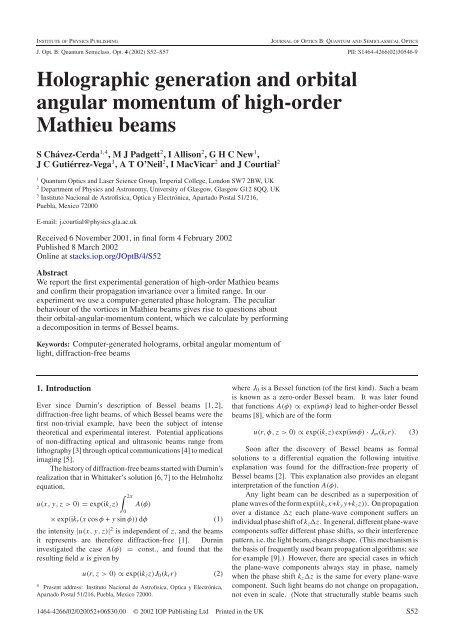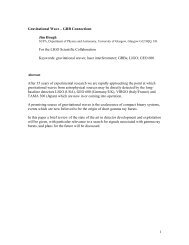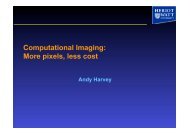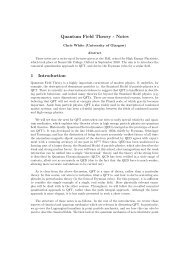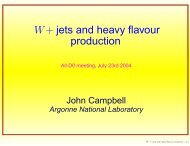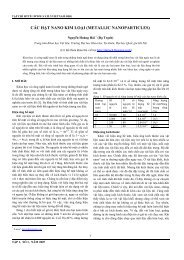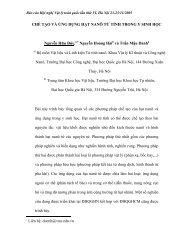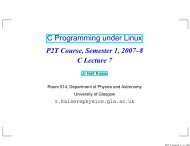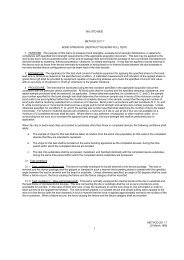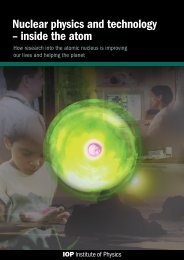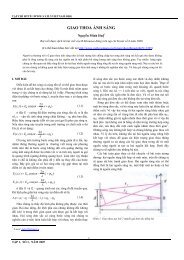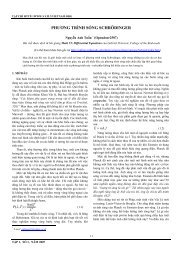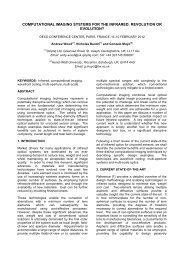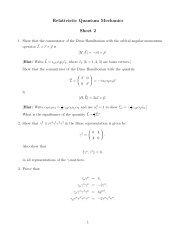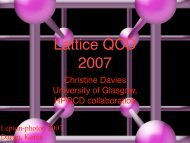Holographic generation and orbital angular momentum of high ...
Holographic generation and orbital angular momentum of high ...
Holographic generation and orbital angular momentum of high ...
Create successful ePaper yourself
Turn your PDF publications into a flip-book with our unique Google optimized e-Paper software.
INSTITUTE OF PHYSICS PUBLISHINGJOURNAL OF OPTICS B: QUANTUM AND SEMICLASSICAL OPTICSJ. Opt. B: Quantum Semiclass. Opt. 4 (2002) S52–S57 PII: S1464-4266(02)30546-9<strong>Holographic</strong> <strong>generation</strong> <strong>and</strong> <strong>orbital</strong><strong>angular</strong> <strong>momentum</strong> <strong>of</strong> <strong>high</strong>-orderMathieu beamsSChávez-Cerda 1,4 , M J Padgett 2 , I Allison 2 ,GHCNew 1 ,JCGutiérrez-Vega 3 ,ATO’Neil 2 ,IMacVicar 2 <strong>and</strong> J Courtial 21 Quantum Optics <strong>and</strong> Laser Science Group, Imperial College, London SW7 2BW, UK2 Department <strong>of</strong> Physics <strong>and</strong> Astronomy, University <strong>of</strong> Glasgow, Glasgow G12 8QQ, UK3 Instituto Nacional de Astr<strong>of</strong>isica, Optica y Electrónica, Apartado Postal 51/216,Puebla, Mexico 72000E-mail: j.courtial@physics.gla.ac.ukReceived 6 November 2001, in final form 4 February 2002Published8March2002Onlineatstacks.iop.org/JOptB/4/S52AbstractWe report the first experimental <strong>generation</strong> <strong>of</strong> <strong>high</strong>-order Mathieu beams<strong>and</strong> confirm their propagation invariance over a limited range. In ourexperiment we use a computer-generated phase hologram. The peculiarbehaviour <strong>of</strong> the vortices in Mathieu beams gives rise to questions abouttheir <strong>orbital</strong>-<strong>angular</strong>-<strong>momentum</strong> content, which we calculate by performinga decomposition in terms <strong>of</strong> Bessel beams.Keywords: Computer-generated holograms, <strong>orbital</strong> <strong>angular</strong> <strong>momentum</strong> <strong>of</strong>light, diffraction-free beams1. IntroductionEver since Durnin’s description <strong>of</strong> Bessel beams [1, 2],diffraction-free light beams, <strong>of</strong> which Bessel beams were thefirst non-trivial example, have been the subject <strong>of</strong> intensetheoretical <strong>and</strong> experimental interest. Potential applications<strong>of</strong> non-diffracting optical <strong>and</strong> ultrasonic beams range fromlithography [3] through optical communications [4] to medicalimaging [5].The history <strong>of</strong> diffraction-free beams started with Durnin’srealization that in Whittaker’s solution [6, 7] to the Helmholtzequation,u(x, y, z > 0) = exp(ik z z)∫ 2π0A(φ)× exp(ik r (x cos φ + y sin φ))dφ (1)the intensity |u(x, y, z)| 2 is independent <strong>of</strong> z, <strong>and</strong> the beamsit represents are therefore diffraction-free [1]. Durnininvestigated the case A(φ) = const., <strong>and</strong> found that theresulting field u is given byu(r, z > 0) ∝ exp(ik z z)J 0 (k r r) (2)4 Present address: Instituto Nacional de Astr<strong>of</strong>isica, Optica y Electrónica,Apartado Postal 51/216, Puebla, Mexico 72000.where J 0 is a Bessel function (<strong>of</strong> the first kind). Such a beamis known as a zero-order Bessel beam. It was later foundthat functions A(φ) ∝ exp(imφ) lead to <strong>high</strong>er-order Besselbeams [8], which are <strong>of</strong> the formu(r,φ,z > 0) ∝ exp(ik z z) exp(imφ) · J m (k r r). (3)Soon after the discovery <strong>of</strong> Bessel beams as formalsolutions to a differential equation the following intuitiveexplanation was found for the diffraction-free property <strong>of</strong>Bessel beams [2]. This explanation also provides an elegantinterpretation <strong>of</strong> the function A(φ).Any light beam can be described as a superposition <strong>of</strong>plane waves <strong>of</strong> the form exp(i(k x x+k y y+k z z)). On propagationover a distance z each plane-wave component suffers anindividual phase shift <strong>of</strong> k z z. In general, different plane-wavecomponents suffer different phase shifts, so their interferencepattern, i.e. the light beam, changes shape. (This mechanism isthe basis <strong>of</strong> frequently used beam propagation algorithms; seefor example [9].) However, there are special cases in whichthe plane-wave components always stay in phase, namelywhen the phase shift k z z is the same for every plane-wavecomponent. Such light beams do not change on propagation,not even in scale. (Note that structurally stable beams such1464-4266/02/020052+06$30.00 © 2002 IOP Publishing Ltd Printed in the UK S52
SChávez-Cerda et alA 1Hf 1L 1A 2-2-1f 20L 2+1f 1+2f 2H′zCFigure 3. Schematic <strong>of</strong> the experiment for the holographic<strong>generation</strong> <strong>of</strong> <strong>high</strong>er-order Mathieu beams. The phase hologram His illuminated by a beam truncated by the circular aperture A 1 .Inthe focal plane <strong>of</strong> lens L 1 the circular aperture A 2 picks out thebright ring <strong>of</strong> the first diffraction order, which is then turned into adiffraction-free beam by the lens L 2 . The CCD array C allows theintensity cross sections <strong>of</strong> the resulting beam to be recorded atvarious distances z behind the image <strong>of</strong> the hologram, H ′ . The focallengths used in our experiment were f 1 = 600 mm <strong>and</strong>f 2 = 250 mm.(a)(b)-2 -1 0 +1 +2Figure 4. Experimentally recorded intensity cross sections in thefocal plane <strong>of</strong> a lens behind Mathieu-beam phase holograms undertop-hat illumination for k r = 3 × 10 4 m −1 (recorded behind m = 5<strong>and</strong> q = 7 hologram, see figure 2) (a) <strong>and</strong>fork r = 4 × 10 4 m −1(recorded behind m = 5<strong>and</strong>q = 20 hologram) (b). The diffractionorders are identified at the bottom.z max =rtan θ . (5) allowing the zeroth-order diffracted beam to pass through theaperture A 2 . Comparison with figure 2 confirms that the beamsFigure 5. Intensity cross sections <strong>of</strong> different experimentallygenerated <strong>high</strong>er-order Mathieu beams at different distances zbehind the plane H ′ (see figure 3). The three different beamscorrespond to the three holograms shown in figure 2. The arearepresented by each image is approximately 0.5 mm by 0.4 mm.Here r is the radius <strong>of</strong> the beam in the plane <strong>of</strong> the aperture (thebase <strong>of</strong> the cone) <strong>and</strong> θ is the inclination angle <strong>of</strong> the beam’splane-wave components with respect to the optical axis. Therelevant aperture in our experiment is the image <strong>of</strong> A 1 in theplane H ′ , which has a radius <strong>of</strong> r ≈ 1.6 mm (the radius <strong>of</strong> A 1is about 3.75 mm, <strong>and</strong> its image in the plane H ′ is magnifiedby a factor <strong>of</strong> M =−f 2 /f 1 ≈−0.42). The angle θ can becalculated from the equation tan θ ≈ sin θ = k r /k, whichinour experiment evaluated to θ ≈ 0.55 ◦ <strong>and</strong> θ ≈ 0.42 ◦ forholograms with k r = 4 × 10 4 m −1 <strong>and</strong> k r = 3 × 10 4 m −1 ,respectively. (Note that imaging the beam from the plane Hinto the plane H ′ with magnification M changes k r by afactor 1/|M|.) These values lead to respective diffractionfreedistances <strong>of</strong> r max ≈ 162 mm (for θ ≈ 0.55 ◦ )<strong>and</strong>r max ≈ 215 mm (θ ≈ 0.42 ◦ ), which are in good agreementwith the distances after which the centre <strong>of</strong> the beams in ourexperiment became much fainter (figure 5).Figure 6 shows interference patterns between the Mathieubeams <strong>and</strong> an inclined plane wave, illustrating the phasestructure <strong>of</strong> the beams. The plane wave was obtained by alsoperfect circle. As this plane also happens to be the front focalplane <strong>of</strong> lens L 2 , our set-up is essentially <strong>of</strong> the type shownin figure 1; the first part <strong>of</strong> the set-up, including illumination,hologram, lens L 1 , <strong>and</strong> aperture A 2 , is therefore simply a way<strong>of</strong> creating, in the front focal plane <strong>of</strong> lens L 2 , a ring-shapedlight field with the azimuthal field dependence A(φ) that leadsto a Mathieu beam behind the lens.Figure 5 shows intensity cross sections through theMathieu beams produced with the holograms shown in figure 2.It can clearly be seen that the beams are diffraction free onlyover a finite distance, z max , the so-called propagation-invariantregion, behind which the centre <strong>of</strong> the beam rapidly becomesfainter. This is a well known effect due to the finite size <strong>of</strong>the beam. The slight rotation about the optical axis withinthe propagation-invariant region, which can also be seen infigure 5, has been predicted theoretically very recently [11]<strong>and</strong> is also due to the beam’s finite size. The distance z maxcan be estimated geometrically to be the length <strong>of</strong> the conein which all the plane-wave components in the beam intersect(see figure 1), which is given by [1]S54
SChávez-Cerda et alm = 6, q = 0m = 6, q = 18m = 6, q = 27m = 6, q = 72|u(x,y)| 2108×3arg(A(φ)) |A(φ)| 2 arg(u(x,y))δl z (φ)|A l | 2~δL z /64200 50 100 150qFigure 10. OAM per photon, δL z , <strong>of</strong> Mathieu beams with m indicesbetween 0 <strong>and</strong> 10, plotted as a function <strong>of</strong> q. Thecurvecorresponding to a specific value <strong>of</strong> m starts <strong>of</strong>f at q = 0 with avalue δL z (0) = m¯h. The dotted line crosses these curvesapproximately at the critical values q c . The circles mark the casesthat are shown in more detail in figure 9.-10 0 10 -10 0 10 -10 0 10 -10 0 10Figure 9. Examples <strong>of</strong> Mathieu beams <strong>and</strong> calculation <strong>of</strong> their<strong>orbital</strong> <strong>angular</strong> momenta. In the back focal plane <strong>of</strong> a lens, theMathieu beams described by the functions u(x, y) (shown are theintensity <strong>and</strong> phase cross sections, |u(x, y)| 2 <strong>and</strong> arg(u(x, y)))arethin bright rings with an <strong>angular</strong> amplitude distribution <strong>of</strong> the formA(φ) (again, the intensity <strong>and</strong> phase distributions are shown over thefull φ range between 0 <strong>and</strong> 2π). The local OAM per photon, δl z (φ)(the vertical range corresponds to values between 0 <strong>and</strong> 20¯h), can becalculated from arg(A(φ)). The power spectra <strong>of</strong> A(φ), |Ã l | 2 ,arealso the Bessel-beam spectra <strong>of</strong> the corresponding Mathieu beams.The respective <strong>orbital</strong> <strong>angular</strong> momenta per photon, δL z ,are6¯h(q = 0), 4.92¯h (q = 18), 4.40¯h (q = 27) <strong>and</strong> 6.32¯h (q = 72). In thecase q = 72 numerous additional vortices can be spotted in thebeam’s phase cross section, arg(u(x, y)).Note that regions <strong>of</strong> zero intensity, such as for examplethe cylindrical surfaces <strong>of</strong> zero-field amplitude in Besselbeams, do not contribute to δL z —the density <strong>of</strong> OAM is zerothere.When calculating the OAM content <strong>of</strong> perfectlydiffraction-free light beams, it is useful to be aware <strong>of</strong> some<strong>of</strong> their peculiarities. Most importantly, perfectly diffractionfreelight beams are infinitely wide—this is the reason whyexperimental realizations <strong>of</strong> diffraction-free beams, whichare always limited by a finite aperture, can only ever beapproximations <strong>and</strong> do exhibit diffraction effects, such asthe finite range <strong>of</strong> ‘diffraction-free’ propagation observed insection 2 [2]. Closely related to their infinite width is theinfinite energy content <strong>of</strong> perfectly diffraction-free light beams.Bessel beams, for example, have approximately the same—finite—amount <strong>of</strong> energy in each <strong>of</strong> the concentric bright rings,<strong>of</strong> which there are infinitely many [1]. As the OAM per photon,δL z , is proportional to the ratio <strong>of</strong> OAM <strong>and</strong> energy, perfectlydiffraction-free beams with non-zero values <strong>of</strong> δL z thereforepossess an infinite OAM.Perhaps the following subtle point merits a briefdiscussion: the OAM flux (equation (8)) was calculated withrespect to the origin. At first this might appear to restrictthe generality <strong>of</strong> this approach; however, as the OAM <strong>of</strong> alight beam in the direction <strong>of</strong> the beam’s propagation direction(more precisely the direction <strong>of</strong> the <strong>momentum</strong> vector <strong>of</strong> theentire beam) is independent <strong>of</strong> the choice <strong>of</strong> axis <strong>and</strong> thereforeintrinsic [21], it does not matter relative to which axis itis calculated, as long as the axis is parallel to the beam’spropagation direction.Numerically, the gradients in equation (7) can beapproximated by finite differences, for example in the form∂u/∂x ≈ (u(x + , y) − u(x − , y))/(2), <strong>and</strong> theintegration in equation (9) can be replaced by a summationover a discrete number <strong>of</strong> values. The OAM per photon cantherefore be calculated quite easily from values <strong>of</strong> u(x, y) at afinite number <strong>of</strong> points on a beam cross section.It can be shown that in polar coordinates the expressionfor δl z becomesδl z (r,φ)= d(r,φ)dφ· ¯h (10)where (r,φ)is the phase cross section <strong>of</strong> the light beam. (Forthe local OAM per photon <strong>of</strong> a light beam with an azimuthalphase dependence <strong>of</strong> the form (φ) = lφ this gives δl z = l¯heverywhere <strong>and</strong> therefore δL z = l¯h, as expected [20]. Astheir azimuthal phase term is <strong>of</strong> the form exp(imφ), Mathieubeams with q = 0 (i.e. Bessel beams) have an azimuthal phasedependence <strong>of</strong> the form (φ) = mφ <strong>and</strong> therefore an OAMper photon <strong>of</strong> δL z = m¯h.) For diffraction-free beams, thisexpression can be evaluated in the far field, where the intensitycross section is simply a bright circle. In terms <strong>of</strong> the fielddistribution on this circle, A(φ), equation (10) becomesδl z (φ) = d arg(A(φ)) · ¯h. (11)dφFigure 9 shows some examples <strong>of</strong> intensity <strong>and</strong> phase crosssections through Mathieu beams, alongside the correspondingfunctions A(φ) <strong>and</strong> the local OAM per photon, δl z (φ).S56
Note that care has to be taken with 2π phase jumps in thefunction arg(A(φ)).A completely different approach for the calculation <strong>of</strong> theOAM per photon in a light beam involves a decompositionin terms <strong>of</strong> beams components with known <strong>orbital</strong> <strong>angular</strong>momenta, like for example Laguerre–Gaussian beams orBessel beams (equation (3)), which have an azimuthal phaseterm <strong>of</strong> the form exp(ilφ), i.e. an azimuthal phase dependence(φ) = lφ, <strong>and</strong> therefore an OAM per photon <strong>of</strong> l¯h. Thesum<strong>of</strong> the per-photon <strong>orbital</strong> <strong>angular</strong> momenta <strong>of</strong> these individualbeam components, weighted by the corresponding relativeintensities, is the OAM per photon <strong>of</strong> the beam as a whole.Diffraction-free beams are special in that they can bedecomposed very easily in terms <strong>of</strong> Bessel beams: a Fouriertransform <strong>of</strong> the azimuthal amplitude distribution in the farfield (or at the focus <strong>of</strong> a lens), A(φ), taking into accountthat A(φ) is 2π-periodic, yields the discrete set <strong>of</strong> Fouriercoefficients à l <strong>of</strong> the exp(ilφ) components <strong>of</strong> the beam(equation (47) in [22]). The OAM per photon in the beamis simply∑lδL z =l|à l | 2∑l |à · ¯h. (12)l |2Alongside beam cross sections, u(x, y), azimuthal fielddistributions in the far field, A(φ), <strong>and</strong> corresponding local<strong>orbital</strong> <strong>angular</strong> momenta per photon, figure 9 also shows arepresentation <strong>of</strong> the Fourier coefficients, à l , for some Mathieubeams.4. Orbital <strong>angular</strong> <strong>momentum</strong> <strong>of</strong> Mathieu beamsIn light beams with a phase structure <strong>of</strong> the form exp(ilφ), likefor example Bessel beams, the local OAM per photon, δl z ,hasthe constant value l¯h everywhere, which is also the value <strong>of</strong> thebeam’s OAM per photon, δL z . This is not the case in Mathieubeams, which exhibit a much more complex phase structure.Figure 10 shows plots <strong>of</strong> δL z as a function <strong>of</strong> q forMathieu beams with m = 0, 1,...,10; for negative values<strong>of</strong> m, δL z simply changes sign. The curves were obtainedby calculating the m coordinate <strong>of</strong> the centre <strong>of</strong> gravity <strong>of</strong>the power spectrum <strong>of</strong> A(φ), as outlined in section 3. Apartfrom the curve for m = 0, which is zero everywhere, thecurves all start from δL z = m¯h at q = 0 <strong>and</strong>, as q increases,smoothly decrease, pass through a minimum, <strong>and</strong> increaseagain, sometimes crossing the curve for a different value <strong>of</strong> m.For m =±1, the minimum appears to be located at q = 0.The curves are continuous everywhere, including at the criticalvalues q c , where numerous new vortices start to appear in thebeam.5. ConclusionsWe have reported the first experimental <strong>generation</strong> <strong>of</strong> <strong>high</strong>erorderMathieu beams. We show that important properties <strong>of</strong>the holographic method used are illustrated very clearly whenapplied to diffraction-free beams; in particular, the effect <strong>of</strong>uniform illumination <strong>of</strong> the hologram manifests itself in thefar fieldintheform<strong>of</strong>‘radial harmonics’, i.e. additional ringswhose radius is an integer multiple <strong>of</strong> the ‘fundamental’ ring.We have also calculated the OAM content <strong>of</strong> all Mathieu beamswithin a large area <strong>of</strong> parameter space.AcknowledgmentsGeneration <strong>of</strong> <strong>high</strong>-order Mathieu beamsSC-C acknowledges support by the Engineering <strong>and</strong> PhysicalSciences Research Council (grant no GR/N37117/01). Thiswork was partially supported by Consejo Nacional de Cienciay Tecnologia. MJP <strong>and</strong> JC acknowledge support from theRoyal Society.References[1] Durnin J 1987 Exact solutions for nondiffracting beams: I.The scalar theory J. Opt. Soc. Am. A 4 651–4[2] DurninJ,MiceliJJJ<strong>and</strong>EberlyJH1987 Diffraction-freebeams Phys.Rev.Lett.58 1499–501[3] Erdélyi M, Horváth Z L, Szabó G, Bor S, Tittel F K,Cavallaro J R <strong>and</strong> Smayling M C 1997 Generation <strong>of</strong>diffraction-free beams for applications in opticalmicrolithography J. Vac. Sci. Technol. B15 287[4] Lu J-Y <strong>and</strong> He S 1999 Optical X wave communications Opt.Commun. 161 187–92[5] Lu J-Y <strong>and</strong> Greenleaf J F 1994 A study <strong>of</strong> two-dimensionalarray transducers for limited diffraction beams IEEE Trans.Ultrason. Ferroelectr. Freq. Control 41 724–39[6] Whittaker E T 1902 On the partial differential equations <strong>of</strong>mathematical physics Math. Ann. 57 333–55[7] Whittaker E T <strong>and</strong> Watson G N 1927 A Course <strong>of</strong> ModernAnalysis 4th edn (Cambridge: Cambridge University Press)ch XVIII–XIX[8] Vasara A, Turunen J <strong>and</strong> Friberg A T 1989 Realization <strong>of</strong>general nondiffracting beams with computer-generatedholograms J. Opt. Soc. Am. A 6 1748–54[9] Sziklas E A <strong>and</strong> Siegman A E 1975 Mode calculation inunstable resonators with flowing saturable gain: 2: FastFourier transform method Appl. Opt. 14 1874–89[10] Gutiérrez-Vega J C, Iturbe-Castillo M D <strong>and</strong> Chávez-Cerda S2000 Alternative formulation for invariant optical fields:Mathieu beams Opt. Lett. 25 1493–5[11] Chávez-Cerda S, Gutiérrez-Vega J C <strong>and</strong> New G H C 2001Elliptic vortices <strong>of</strong> electromagnetic wavefields Opt. Lett. 261803–5[12] Gutiérrez-Vega J C, Rodríguez-Dagnino R <strong>and</strong>Chávez-Cerda S 2002 Attentuation characteristics in confocalannular elliptic waveguides <strong>and</strong> resonators IEEE Trans.Microwave Theory <strong>and</strong> Techniques at press[13] McLachlan N W 1951 Theory <strong>and</strong> Applications <strong>of</strong> MathieuFunctions (London: Clarendon)[14] Berry M 1981 Singularities in waves <strong>and</strong> rays Les HouchesLecture Series Session XXXV ed R Balian, M Kléman <strong>and</strong>J-P Poirier (Amsterdam: North-Holl<strong>and</strong>) pp 453–543[15] Soskin M S <strong>and</strong> Vasnetsov M V 2001 Singular optics Prog.Opt. 42 219–76[16] Gutiérrez-Vega J C, Iturbe-Castillo M D, TepichínE,Rodríguez-Dagnino R M, Chávez-Cerda S <strong>and</strong> New G H C2001 Experimental demonstration <strong>of</strong> optical Mathieu beamsOpt. Commun. 195 35–40[17] Turunen J, Vasara A <strong>and</strong> Friberg A T 1988 <strong>Holographic</strong><strong>generation</strong> <strong>of</strong> diffraction-free beams Appl. Opt. 27 3959–62[18] O’Neil A T 2001 PhD Thesis University <strong>of</strong> St Andrews[19] Bjelkhagen H I 1993 Silver-Halide Recording Materials(Berlin: Springer) ch 5[20] Allen L, Beijersbergen M W, Spreeuw R J C <strong>and</strong> WoerdmanJ P 1992 Orbital <strong>angular</strong> <strong>momentum</strong> <strong>of</strong> light <strong>and</strong> thetransformation <strong>of</strong> Laguerre–Gaussian modes Phys. Rev. A45 8185–9[21] Berry M 1998 Paraxial beams <strong>of</strong> spinning light SingularOptics ed M S Soskin Proc. SPIE 3487 (SPIE Int. Soc. Opt.Engng.) (Bellingham, Washington, USA) pp 1–5[22] Siegman A E 1986 Lasers (Mill Valley, CA: UniversityScience Books)S57


